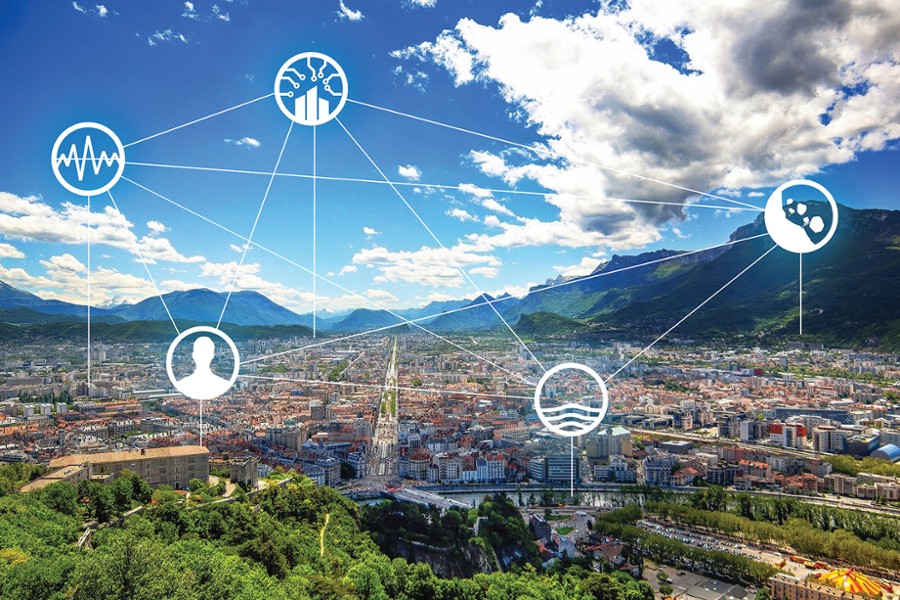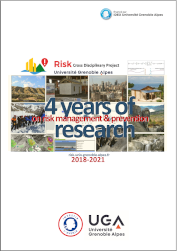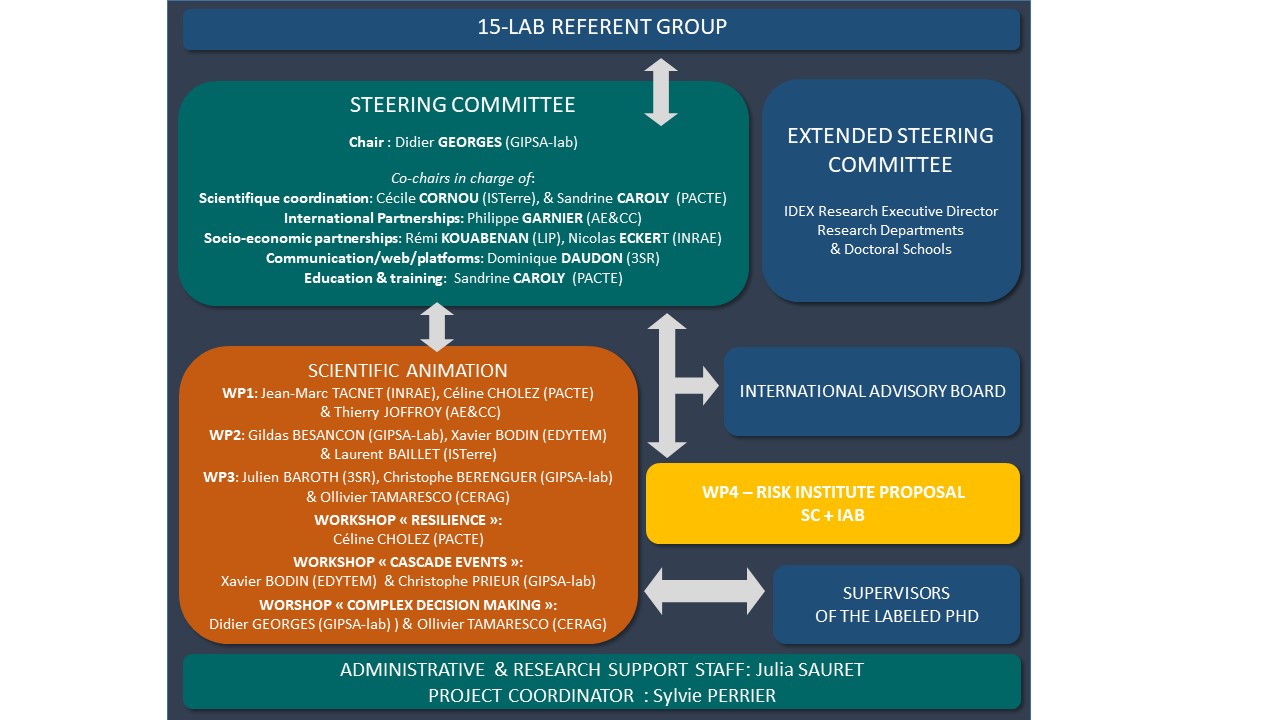- Share
- Share on Facebook
- Share on X
- Share on LinkedIn
First step to interdisciplinarity

The Cross Disciplinary Program (CDP) Risk is one of 17 projects funded by IDEX Université Grenoble Alpes from 2019 to 2021. Managed by the institution's Research, Innovation and Valorization department, this program has funded 11 cotutelle theses in the field of risk and organized several interdisciplinary events between 2017 and 2021.
Steering Committee
Chair: Didier GEORGES (Gipsa-Lab)
Co-Chairs: Cécile CORNOU (ISTerre), Sandrine CAROLY (PACTE), Philippe GARNIER (AE&CC), Nicolas ECKERT (INRAE), Rémi KOUABENAN (LIP), Dominique DAUDON (3SR)
The Risk project’s goal was to develop cross-disciplinary research and scientific innovation in the field of disaster and risk management, specifically in areas that are made vulnerable due to a strong interdependency between human, natural or technological hazards. In addition to the Grenoble basin, the project had focused on other specific vulnerable territories such as the Beirut area (Lebanon), Port-au-Prince (Haiti), and areas in Peru and in Nepal. The project also aimed at proposing a risk institute within Univ. Grenoble Alpes.
Challenges
The main goal of the project was to contribute to the proactive mitigation of disaster risks and the development of the culture of risk. It was dedicated to a global and regional challenge, which is fundamental for the decades to come, due to the increase of the world population with often-anarchic densification of urbanized areas, the increasing human impact on ecosystems, but also the emergence of new risks induced by climate change and technological development.
Interdisciplinarity
The project federated a hundred researchers belonging to 15 research labs from Human and Social Sciences, Information and System Sciences, Geosciences, and Engineering Sciences. The scientific challenges of collecting and processing heterogeneous data, modeling complex and cascaded phenomena, multi-objective decision making, and assessing or defining risk governance schemes required truly global and interdisciplinary approaches.
Review of scientific results 2018-2021
This review gives an overview of the scientific work carried out around risk management in the laboratories of the University of Grenoble Alpes through the activity of the Cross Disciplinary Project RISK from 2018 to 2021.
Project’s organization…
The project proposed an innovative scientific approach to address the following challenging issues: managing data heterogeneity through a participatory approach; integrating rare or emergent events and cascading effects; moving from a static/reactive risk management approach to a proactive/dynamic approach; and designing appropriate strategies for, on the one hand, disaster risk reduction (apart from a relevant assessment of vulnerabilities and local cultures) and for communications on the other, in order to better manage risk and strengthen the culture of risk.
… and its international visibility
The project was fully in line with Sendai’s United Nations conference framework on disaster risk prevention in 2015, which encourages countries to better prevent and anticipate disaster risks. It aimed at becoming a privileged interlocutor of the risk management stakeholders in France and abroad, in particular on the 5 selected study sites (economic sphere, public authorities, humanitarian organizations, academia or risk center networks).
The project offered a strong contribution to both the structure and visibility of Univ. Grenoble Alpes in the field of risk assessment and management, by proposing in fine a risk management institute, unique in France. The CDP Risk fostered the development of new interdisciplinary methodologies by research teams to better work together, and contributed to the transfer of research results to relevant stakeholders and decision-makers. It had also actively participated in reinforcing interdisciplinary curricula in risk management.
Click on the figure to enlarge
Research approach & Work packages
The project was organized in 4 work-packages:
- WP1 was dedicated to Risk management and governance modes
- WP2 dealt with the problem of acquiring, processing and modeling some heterogeneous data sets coming from different sources (human and instrumental data) for characterizing and understanding complex systems
- WP3 focused on the development of innovative approaches for multifactorial risk assessment and decision-making support for active risk/disaster mitigation, post-disaster response and disaster recovery
- WP4 was dedicated to the design of a proposal for a future world-class Risk Institute in Grenoble
The following field sites were the focus of the research studies:
The Alpine Area
- Grenoble basin (impacts of floods and landslides, #T2, #T9) with a support of Urban Planning Agency of Grenoble area
- Harmalière landslide site (#T3, #T6),
- Alpine cryosphere /glaciers (Vanoise, #T5, #P2) with emergent hazards
International stage
- Peru (#T10)
- Haiti (#T11, #P3)
- Nepal (#T8, #P3)
- Lebanon (Beirut, #T7, #M3) for earthquakes.
The four foreign sites have been chosen for the scientific opportunities that they offer in seismic risk management. The sacred valley in Peru (#T10) allows archeological sites to be used as valuable markers for paleoseismicity and risk studies, including local resilience.
Haiti (#T11) and Nepal (#T8) are two countries recently affected by strong and destroying earthquakes and the research were focused on the resilience and strategy in post-disaster reconstruction projects in two different contexts.
Finally, Beirut (Lebanon) is a megapole strongly at risk (#T7), where the numerous collected data allow modeling of living-risk situations, including the impact of individual behavior on fatalities.
More prospectively, the Mekong Delta megalopolis area in Vietnam through possible collaborations with CARE international lab (Centre Asiatique de Recherche sur l’Eau) prone to increasing flooding hazards might be considered in the future.
11 PhDs of the project CDP RISK
#T1 Bayesian estimation of extreme risk measures: Implication for the insurance of natural disasters
Poster "Application to agricultural insurance"
| Supervisors | Doctoral Schools | Relevant WP(s) | PhD |
|---|---|---|---|
| Stéphane Girard (LJK / INRIA stephane.girard  inria.fr (stephane[dot]girard[at]inria[dot]fr)), inria.fr (stephane[dot]girard[at]inria[dot]fr)), Geoffroy Enjolras (CERAG, geoffroy.enjolras  univ-grenoble-alpes.fr (geoffroy[dot]enjolras[at]univ-grenoble-alpes[dot]fr)) univ-grenoble-alpes.fr (geoffroy[dot]enjolras[at]univ-grenoble-alpes[dot]fr)) |
MSTII | WP3 |
|
#T2 Coordination of action between heterogeneous stakeholders in management of crisis
Poster "A conceptual model of avalanche crisis management"
| Supervisors | Doctoral Schools | Relevant WP(s) | PhD |
|---|---|---|---|
| Sandrine Caroly (PACTE Sandrine.caroly  univ-grenoble-alpes.fr (Sandrine[dot]caroly[at]univ-grenoble-alpes[dot]fr)), univ-grenoble-alpes.fr (Sandrine[dot]caroly[at]univ-grenoble-alpes[dot]fr)),Yann Laurillau (LIG, yann.laurillau  univ-grenoble-alpes.fr (yann[dot]laurillau[at]univ-grenoble-alpes[dot]fr)) univ-grenoble-alpes.fr (yann[dot]laurillau[at]univ-grenoble-alpes[dot]fr)) |
SHPT | WP1 | Aurélie PEILLON PACTE |
#T3 Testimonies, perception and management of landslides hazards
Poster "An interdisciplinary approach to disaster risk reduction"
| Supervisors | Doctoral Schools | Relevant WP(s) | PhD |
|---|---|---|---|
| Rémi Kouabénan (LIP, remi.kouabenan  univ-grenoble-alpes.fr (remi[dot]kouabenan[at]univ-grenoble-alpes[dot]fr)), univ-grenoble-alpes.fr (remi[dot]kouabenan[at]univ-grenoble-alpes[dot]fr)), Denis Jongmans (ISTerre, denis.jongmans  univ-grenoble-alpes.fr (denis[dot]jongmans[at]univ-grenoble-alpes[dot]fr)) univ-grenoble-alpes.fr (denis[dot]jongmans[at]univ-grenoble-alpes[dot]fr))Philippe Schoeneich (IUGA/PACTE, philippe.schoeneich  univ-grenoble-alpes.fr (philippe[dot]schoeneich[at]univ-grenoble-alpes[dot]fr)) univ-grenoble-alpes.fr (philippe[dot]schoeneich[at]univ-grenoble-alpes[dot]fr)) |
SHPT | WP2, WP3 | Maria HAGL LIP/PC2S |
#T4 Deterioration modelling and performance assessment of protection systems/structures against natural risks: application to monitoring and preventive maintenance of torrent check dams
| Supervisors | Doctoral Schools | Relevant WP(s) | PhD |
|---|---|---|---|
| Christophe Bérenguer (GIPSA-lab, christophe.berenguer  grenoble-inp.fr (christophe[dot]berenguer[at]grenoble-inp[dot]fr)), grenoble-inp.fr (christophe[dot]berenguer[at]grenoble-inp[dot]fr)), Jean-Marc Tacnet (INRAE, jean-marc.tacnet  inrae.fr (jean-marc[dot]tacnet[at]inrae[dot]fr)) inrae.fr (jean-marc[dot]tacnet[at]inrae[dot]fr)) |
EEATS | WP3 interaction with WP1 & WP2 | Nour CHAHROUR INRAE |
#T5 Emerging risks related to the ‘dark side of the Alpine cryosphere’
Poster "Why the rock and debris covered glaciers is being consideering like an emergen risk?"
Pre-selected among the " Co-financing for three-year doctoral programs -Make Our Planet Great Again"
| Supervisors | Doctoral Schools | Relevant WP(s) | PhD |
|---|---|---|---|
| Antoine Rabatel (IGE, antoine.rabatel  univ-grenoble-alpes.fr (antoine[dot]rabatel[at]univ-grenoble-alpes[dot]fr)), univ-grenoble-alpes.fr (antoine[dot]rabatel[at]univ-grenoble-alpes[dot]fr)),Xavier Bodin (EDYTEM, Xavier.bodin  univ-smb.fr (Xavier[dot]bodin[at]univ-smb[dot]fr)) univ-smb.fr (Xavier[dot]bodin[at]univ-smb[dot]fr)) |
TUE | WP2 | Diego CUSICANQUI EDYTEM |
#T6 Modeling and information reconstruction from heterogeneous data in the context of gravitational hazards – Application to Harmalière’s landslide
Poster "Application to Harmalière landslide"
| Supervisors | Doctoral Schools | Relevant WP(s) | PhD |
|---|---|---|---|
| Gildas Besançon (GIPSA-lab, gildas.besancon  grenoble-inp.fr (gildas[dot]besancon[at]grenoble-inp[dot]fr)), grenoble-inp.fr (gildas[dot]besancon[at]grenoble-inp[dot]fr)), Guillaume Chambon (INRAE, guillaume.chambon  irstea.fr (guillaume[dot]chambon[at]irstea[dot]fr)), irstea.fr (guillaume[dot]chambon[at]irstea[dot]fr)), Laurent Baillet (ISTerre, Laurent.baillet  univ-grenoble-alpes.fr (Laurent[dot]baillet[at]univ-grenoble-alpes[dot]fr)) univ-grenoble-alpes.fr (Laurent[dot]baillet[at]univ-grenoble-alpes[dot]fr)) |
EEATS | WP2 | Mohit Mehendra MISHRA GIPSA-Lab |
#T7 An integrated seismic risk modelling approach including human behaviour
Poster "An integrated modeling approach applied to the case of Beirut, Lebanon
Pre-selected among the " Co-financing for three-year doctoral programs -Make Our Planet Great Again"
| Supervisors | Doctoral Schools | Relevant WP(s) | PhD |
|---|---|---|---|
| Elise Beck (PACTE, elise.beck  univ-grenoble-alpes.fr (elise[dot]beck[at]univ-grenoble-alpes[dot]fr)), univ-grenoble-alpes.fr (elise[dot]beck[at]univ-grenoble-alpes[dot]fr)), Cécile Cornou (ISTerre, cecile.cornou  univ-grenoble-alpes.fr (cecile[dot]cornou[at]univ-grenoble-alpes[dot]fr)) univ-grenoble-alpes.fr (cecile[dot]cornou[at]univ-grenoble-alpes[dot]fr)) |
TUE | WP3 | Rouba ISKANDAR ISTerre |
#T8 Experimental analysis of the seismic vulnerability of earth masonry reinforced with horizontal bands
| Supervisors | Doctoral Schools | Relevant WP(s) | PhD |
|---|---|---|---|
| Yannick Sieffert (3SR, Yannick.sieffert  univ-grenoble-alpes.fr (Yannick[dot]sieffert[at]univ-grenoble-alpes[dot]fr)) , univ-grenoble-alpes.fr (Yannick[dot]sieffert[at]univ-grenoble-alpes[dot]fr)) ,Philippe Garnier (AE&CC, philippe.garnier  grenoble.archi.fr (philippe[dot]garnier[at]grenoble[dot]archi[dot]fr)) grenoble.archi.fr (philippe[dot]garnier[at]grenoble[dot]archi[dot]fr))Florent Vieux-Champagne (3SR, florent.vieux-champagne  univ-grenoble-alpes.fr (florent[dot]vieux-champagne[at]univ-grenoble-alpes[dot]fr)) univ-grenoble-alpes.fr (florent[dot]vieux-champagne[at]univ-grenoble-alpes[dot]fr)) |
IMEP-2 | WP3 | Santosh YADAV 3SR |
#T9 The dynamic adaptation of Human–Computer Interfaces to a user's personal, contextual and behavioral responsiveness and decision-making in a natural risks program
Poster "User Interfaces adaptation to users and their environment in a natural risks program"
| Supervisors | Doctoral Schools | Relevant WP(s) | PhD |
|---|---|---|---|
| Sophie Dupuy-Chessa (LIG, sophie.dupuy  univ-grenoble-alpes.fr (sophie[dot]dupuy[at]univ-grenoble-alpes[dot]fr)), univ-grenoble-alpes.fr (sophie[dot]dupuy[at]univ-grenoble-alpes[dot]fr)),Eline Jongmans (CERAG, eline.jongmans  univ-grenoble-alpes.fr (eline[dot]jongmans[at]univ-grenoble-alpes[dot]fr)) univ-grenoble-alpes.fr (eline[dot]jongmans[at]univ-grenoble-alpes[dot]fr)) |
MSTII | WP1, WP2 | Mina ALIPOUR LIG |
#T10 Archeoseismology by the joint approaches of Seismic hazards and Risk Estimation, Prehistorical sites in seismic settings and Architectural Resilience of archeological remains
| Supervisors | Doctoral Schools | Relevant WP(s) | PhD |
|---|---|---|---|
| Laurence Audin (ISTerre, laurence.audin  ird.fr (laurence[dot]audin[at]ird[dot]fr)), ird.fr (laurence[dot]audin[at]ird[dot]fr)), David Gandreau (AE&CC, david.gandreau  grenoble.archi.fr (david[dot]gandreau[at]grenoble[dot]archi[dot]fr)) grenoble.archi.fr (david[dot]gandreau[at]grenoble[dot]archi[dot]fr)) |
TUE | WP1-2-3 | Andy COMBEY ISTerre |
#T11 Understanding the relevance and impact of CDP approach in post-disaster reconstruction projects: the case of ReparH ANR project after the earthquake of Port-au-Prince
Poster "The case of ReparH ANR project after the 2010 earthquake in Haiti"
Pre-selected among the " Co-financing for three-year doctoral programs -Make Our Planet Great Again"
| Supervisors | Doctoral Schools | Relevant WP(s) | PhD |
|---|---|---|---|
| Thierry Joffroy (AE&CC, Thierry.joffroy  grenoble.archi.fr (Thierry[dot]joffroy[at]grenoble[dot]archi[dot]fr)), grenoble.archi.fr (Thierry[dot]joffroy[at]grenoble[dot]archi[dot]fr)),Laurent Daudeville (3SR, laurent.daudeville  univ-grenoble-alpes.fr (laurent[dot]daudeville[at]univ-grenoble-alpes[dot]fr)) univ-grenoble-alpes.fr (laurent[dot]daudeville[at]univ-grenoble-alpes[dot]fr)) |
SHPT | WP1-3 | Harisoa Mampionona Julpheli RAKOTONIRINA AE&CC-CRAterre |
- Share
- Share on Facebook
- Share on X
- Share on LinkedIn

